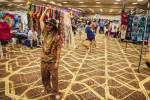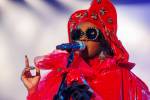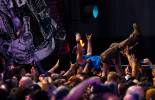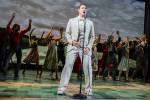Crowd plugs in with Kraftwerk
The audience cheered as the satellite collided with their faces, probe-first.
The thing zoomed above four men in grid-covered body-suits who betrayed less emotion than a quartet of eggplants as they conjured the whirring, plinking, throbbing, occasionally booming sound that filled the room.
The aircraft in question was a 3-D image that soared out from the stage and into the crowd at the Chelsea at The Cosmopolitan of Las Vegas on Saturday, where German electronic music patriarchs Kraftwerk answered the question: can computers generate emotion?
Sure can.
Soccer chants, as well.
Kraftwerk’s multisensory performance, ecstatically greeted by a modestly sized but impassioned crowd who broke into World Cup-worthy choruses of “ole! ole! ole!” at one point, had a back-to-the-future feel to it, equally anachronistic and of-the-moment.
Beginning in the early ’70s, Kraftwerk helped set in machine-like motion the steady progression of electronic music, beginning with minimalist compositions whose base components — mathematically exact rhythms, layers of synthesizer-derived melody, clattering percussion, driving, martial beats — would inform the music of successive generations of musicians ranging from hip-hop producers to post-rock precisionists to every strain of electronic dance music imaginable.
Think of the famous pictograph that chronicles human evolution from primate to man.
If contemporary EDM is the bearded, muscular dude at chart’s end, Kraftwerk is kind of like Homo Erectus, the burly fellow whose use of more advanced tools was instrumental in the development of humankind.
For Kraftwerk, those tools initially consisted of self-made drum pads and stacks of keyboards.
These days, their gear has become decidedly more compact: they perform behind four illuminated consoles whose contents are obscured from the audience, though they likely include a mix of laptops, sequencers, samplers and synths.
They use these machines to continually refine their sound to the extent that, in some instances, it began to resemble the house music that followed in Kraftwerk’s wake.
Songs like “Aero Dynamik” and “Computer Love” were outfitted with more propulsive, muscular beats, their sound more dense and driving than in their original recorded form.
And so, throughout the 135-minute performance, a sense of retro-futurism prevailed.
Visually, the show was mostly evocative of the past: during “Autobahn,” a vintage Volkswagon Bug raced down the highway in question as musical notes floated from an AM/FM car radio; for “Spacelab,” Earth was viewed from the perspective of a space craft whose cockpit looked like something taken from a low budget ’70s sci-fi flick, complete with reel-to-reel recorders; meanwhile, the very idea of a song like “House Phone,” with its images of rotary and push-button phones, seemed quaint in an era where landlines have largely gone the way of the VCR.
But there were times when these contrasting sensibilities merged, most notably on the more prescient songs Kraftwerk performed.
The anti-nuclear “Radioactivity,” which lyrically catalogs cities ravaged by nuclear fall-out, from Chernobyl to Hiroshima, was updated to also include the Fukushima disaster in its accompanying visual list of devastated locations.
“Computer World,” the title track to Kraftwerk’s pioneering eighth album, released in 1981, imagined a future that has since become reality.
“Crime, travel, communication, entertainment,” Kraftwerk founder Ralf Hutter intoned robotically during the song, envisioning a time when the digital realm would play a role in all of the above, a time whose day has since come.
Speaking of which, Kraftwerk’s day too, has come.
The band has earned plenty of critical acclaim over the years and their influence is rightly seen as profound nowadays, but they’ve never enjoyed much commercial success.
But in recent times, Kraftwerk has begun to catch up with their legacy, and as a result, they’ve toured more frequently and in the biggest venues of their career.
To wit, this was the group’s first Vegas performance. (Hutter is the band’s sole original member).
During “Spacelab,” computer-generated images of a flying saucer, which looked kind of like an airborne apple pie, was shown approaching the Las Vegas Strip.
At long last, the space men have landed!
And they’ve brought with them plenty of effects processors.
Contact reporter Jason Bracelin at |jbracelin@reviewjournal.com or 702-383-0476. Follow on Twitter @JasonBracelin.




























